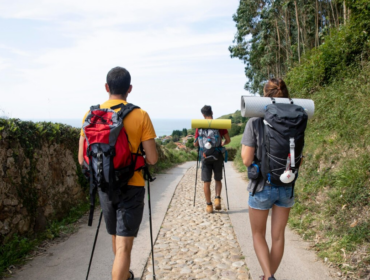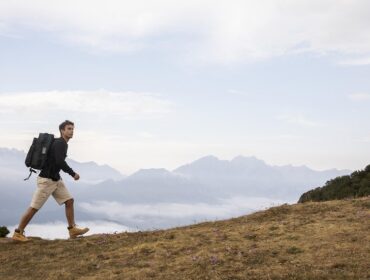Let’s get this out of the way first: nature doesn’t care how expensive your gear is. It cares how you treat it and how you leave it. So if you’re heading outdoors to clear your head, chase views, or breathe in some pine-scented peace, the least you can do is bring a hiking kit that respects the planet you’re exploring.
Building a sustainable hiking kit isn’t about perfection. It’s about making better choices – gear that lasts, materials that matter, and habits that reduce waste. In this guide, we’ll walk through the hiking essentials you need, how to choose gear by function, and how to make sure your kit supports both your journey and the trail under your boots.
Because hiking is supposed to make you feel lighter and not leave a heavy footprint.
First, What Makes Hiking Gear “Sustainable”?
You’ve probably seen the words eco-friendly, recyclable, or biodegradable slapped onto packaging. But when it comes to hiking gear, sustainability is more than a label. It’s about choosing items that are built to last, made with responsible materials, and come from brands that actually walk the talk.
Start by skipping disposable stuff like single-use plastic, flimsy packaging, cheap tools that break halfway through a season. Focus on gear that’s repairable, multi-use, or made with recycled or natural materials. Bonus if it’s made locally or by a company that offsets production or donates to conservation work.
Sustainable doesn’t mean you need to empty your bank account on niche gear. It means thinking long-term. Less waste, fewer replacements, better trails.
Navigation Tools: Finding Your Way Without Leaving a Trace

You don’t need a tech-packed GPS device for every hike. But you do need to know where you’re going. For basic navigation, a good topographic map and a durable compass are all you need. Both can be purchased from brands that use recycled materials or support outdoor education programs.
Prefer a digital approach? Download offline maps to your phone from apps like Google Maps, but use solar-powered chargers or battery packs made by brands focused on renewable energy. Look for minimal packaging or secondhand electronics if you’re upgrading.
And remember – navigation isn’t just about safety. It’s about staying on track so you’re not bushwhacking through fragile habitats or wandering off into protected areas.
Hydration: Ditch the Plastic, Keep the Water Flowing

This one’s easy. Skip bottled water. Always. Bring a reusable bottle or hydration bladder. The Platypus Hoser Hydration Bladder offers lightweight, hands-free hydration with antimicrobial protection and a modular design for easy use on the go. It features a HyperFlow bite valve for smooth sipping and minimal weight.

If you’re hiking longer or refilling from streams, pack a water filter. Gravity systems or UV purifiers from reputable brands reduce plastic waste from purification tablets. Some even come with washable pre-filters to stretch their lifespan. The Steripen Classic 3 UV Water Purifier uses UV light to eliminate microorganisms, offering up to 8,000 treatments for clear water. It’s ideal for groups of up to five and designed for use with already-filtered or visibly clean water.
Hydration is essential but so is how you carry and clean your gear. Go for washable, replaceable parts over single-use anything.
Cooking & Eating: Cut Waste, Not Flavor

No more plastic cutlery or one-time-use dishware. Bring a lightweight set of bamboo or metal utensils. The Primus Campfire Prep Set is a complete outdoor cooking kit featuring self-disinfecting oak utensils and a flexible stainless steel knife. It comes with a dual-pocket cover for easy organization and a wipe-clean interior for hassle-free cleanup. Use a collapsible bowl like the Sea to Summit Frontier Ultralight Collapsible Dinnerware Set. It is a compact, 3-piece kit made from food-grade silicone and reinforced nylon. Lightweight and durable, it collapses to under 2cm and nests perfectly inside the Frontier 2L Pouring Pot. Refillable spice containers? Game changer. Because trail meals shouldn’t be bland, and they don’t need to be wasteful either.
For stoves, pick ones that use fuel canisters you can recycle or refill like the Primus Classic Trail Stove. It features a durable design with a wide, 2800W flame for fast and efficient cooking outdoors. It easily attaches to gas canisters, making it a reliable and long-lasting choice for backcountry meals. And if you’re packing snacks, go for bulk food in reusable silicone bags or beeswax wraps. Single-serve snack packs may be convenient, but they add up fast in trash weight and environmental cost.
Shelter & Sleep: Low Impact, High Comfort

Your tent doesn’t need to be eco-perfect—but it should be built to last. Look for models made with Bluesign®-approved fabrics, which reduce harmful chemicals in production. The Nemo Dagger OSMO 3P Ultralight Backpacking Tent offers expanded space and comfort with increased door and peak height. Made from eco-friendly, water-resistant OSMO fabric, it features quick setup, durable construction, and spacious waterproof storage. It is also Bluesign® verified.
Just don’t forget your groundsheet or footprint. Not only does it protect your tent, it keeps fragile ground cover from getting wrecked underneath.
Hiking Essentials That Work for You and the Earth!
The gear you carry shapes the hike you have but also the world you walk through. Building a sustainable hiking kit doesn’t mean buying all-new gear or stressing over every product tag. It means thinking differently. Buying better. Packing smarter. And caring just a little more about how your gear choices affect the places you love to visit.
Hiking should make you feel connected. Choosing your essentials with intention does exactly that. Every refillable bottle, every multi-use tool, every trail-tested jacket – it adds up. It keeps the wild wild. It keeps the ground under your feet worth exploring.
So next time you gear up, ask: is this good for the trail and good for me?
If the answer’s yes, you’re already doing it right.
FAQs
What’s the most sustainable material for hiking clothes?
Recycled polyester and responsibly sourced merino wool are two of the best options out there.
Are reusable bottles really better than hydration tablets?
Absolutely. Tablets work in emergencies, but reusable bottles with filters reduce plastic waste every single trip.
Do eco-friendly tents actually last longer?
Many do. High-quality materials paired with good care often outlast cheaper, unsustainable models.
Is secondhand gear safe for hiking?
Totally. As long as you check it over before heading out, secondhand gear is a smart, sustainable choice.
Can I build a hiking essentials kit on a budget?
Yes. Start with the basics. Buy quality where it matters. And shop used when possible. Sustainability and savings go hand in hand.





